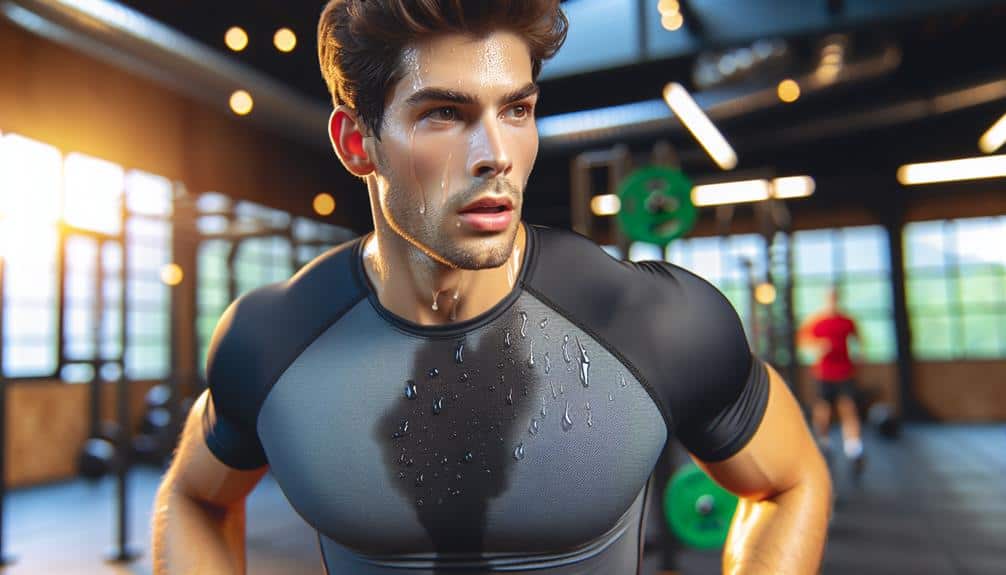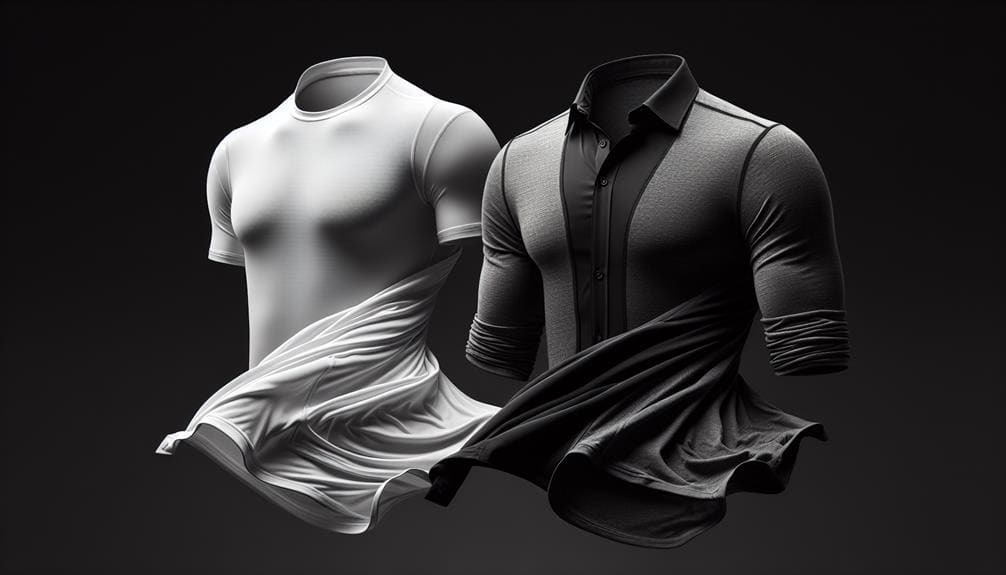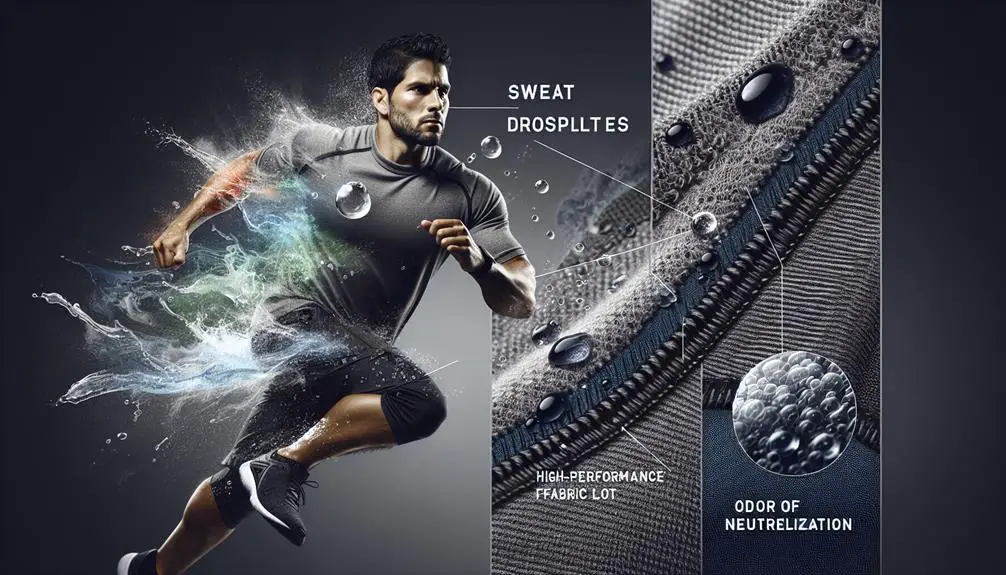To stay odor-free in moisture-wicking shirts, wash with a gentle detergent. Turn shirts inside out and avoid the dryer. Air dry flat with good airflow; sunlight helps kill bacteria. Use natural remedies like lavender or tea tree oils. DIY deodorants with baking soda work well. Evaluate anti-odor products for effectiveness. Scented options may mask odors, but unscented is better for sensitive skin. Understand deodorants vs. antiperspirants. Deodorants control odor, antiperspirants tackle sweat and odor. Master these techniques for fresh shirts.
Key Points
- Wash moisture-wicking shirts promptly after each use to prevent bacterial growth.
- Use natural remedies like lavender or tea tree oils to combat odors effectively.
- Opt for unscented anti-odor products for sensitive skin and better odor control.
- Air dry shirts flat with good air circulation to deter bacterial growth.
- Turn shirts inside out before washing to target sweat and bacteria buildup.
Benefits of Moisture-Wicking Fabrics
When selecting moisture-wicking fabrics for your activewear, consider the many benefits they offer in keeping you dry and comfortable during physical activities. Fabric technology plays an essential role in enhancing your performance during workouts. These fabrics are designed to wick away sweat from your body, allowing it to evaporate quickly, thereby regulating your body temperature. This feature prevents the discomfort of wet, clingy clothing that can occur during intense exercise.
Moisture-wicking fabrics utilize advanced textile engineering to transport moisture away from your skin to the outer surface of the fabric where it can evaporate. This process helps in maintaining your body's natural cooling mechanism. By efficiently managing perspiration, these fabrics reduce the risk of chafing and irritation, enabling you to focus on your workout without distractions. The performance benefits of moisture-wicking fabrics include improved breathability, odor control, and quicker drying times.
Investing in activewear made from these innovative materials can greatly enhance your overall exercise experience.
Understanding Odor-Causing Bacteria
Understanding the mechanism by which odor-causing bacteria proliferate on moisture-wicking fabrics is essential for maintaining garment freshness during physical activities. Bacteria growth and sweat reactions play a vital role in the development of unpleasant odors. Here are key points to help you grasp the science behind this process:
- Bacteria Growth: Sweat provides the perfect breeding ground for bacteria, which thrive in moist environments. As bacteria break down sweat, they release odorous byproducts, leading to the characteristic smell associated with unwashed garments.
- Moisture-Wicking Fabrics: While these fabrics excel at pulling sweat away from your skin, they can still retain moisture in the fibers. This trapped moisture creates an environment where bacteria can flourish and cause odor.
- Sweat Reactions: Different individuals produce varying levels of sweat, which can impact the rate at which bacteria grow on fabric. Understanding your body's sweat patterns can help you manage odor effectively.
- Fabric Care: Properly cleaning moisture-wicking garments is essential to remove bacteria and sweat residue. Following recommended washing techniques can help prolong the freshness of your activewear.
Washing Techniques for Odor Control
To effectively manage odor in moisture-wicking shirts, adhere strictly to recommended washing techniques. When laundering your moisture-wicking shirt, choose hand washing over machine washing. Use a gentle detergent that's specifically formulated for activewear to avoid damage to the fabric and maintain its moisture-wicking properties. Turn the shirt inside out before washing to focus on the areas where bacteria and sweat accumulate the most.
After washing, refrain from using the dryer as the heat can lock in any remaining odors. Instead, air dry your moisture-wicking shirt by laying it flat on a clean surface. Ensure adequate air circulation in the drying area to prevent mildew growth and to allow the fabric to breathe effectively. Direct sunlight can also aid in naturally eliminating bacteria that cause odor.
Natural Remedies for Odor Prevention
For effective odor prevention in moisture-wicking shirts, consider incorporating natural remedies into your garment care routine. When dealing with stubborn odors, herbal solutions and DIY deodorants can be powerful allies in keeping your activewear smelling fresh and clean.
Here are some natural remedies to help you combat odor effectively:
- Herbal Solutions: Utilize the natural antibacterial properties of herbs like lavender, tea tree, or eucalyptus by adding a few drops of their essential oils to your laundry detergent or fabric softener. These herbs can help eliminate odor-causing bacteria and leave a pleasant scent on your moisture-wicking shirts.
- DIY Deodorants: Create your own deodorizing spray by mixing water with baking soda, witch hazel, and a few drops of your favorite essential oil. This homemade deodorant can be spritzed on your shirts before or after wearing them to neutralize odors and keep them smelling fresh throughout the day.
Choosing the Right Anti-Odor Products
Consider evaluating the efficacy of various anti-odor products to determine the most suitable option for your moisture-wicking shirts. When choosing between scented and unscented products, it's important to note that scented options may mask odors but can potentially cause irritation to sensitive skin. Unscented products, on the other hand, are a safer choice for individuals with skin sensitivities and allergies.
Furthermore, understanding the difference between deodorants and antiperspirants is vital. Deodorants work by combating the bacteria that cause odor, while antiperspirants reduce sweat production to minimize wetness and odor. Depending on your needs, you may opt for a deodorant if odor control is your primary concern, or an antiperspirant if you want to address both sweat and odor issues.
Frequently Asked Questions
Can Moisture-Wicking Shirts Prevent Sweat Stains?
Moisture-wicking shirts with advanced fabric technology can help prevent sweat stains by efficiently moving moisture away from your skin. These performance wear garments excel in sweat prevention and odor control, keeping you fresh and comfortable.
How Often Should I Replace My Moisture-Wicking Shirts to Maintain Their Odor-Fighting Properties?
To maintain your moisture-wicking shirt's odor-fighting properties and longevity, consider replacing it every 12-18 months. Washing frequency, proper storage, and fabric care play key roles. Follow manufacturer guidelines for best results.
Are There Any Specific Detergents or Fabric Softeners I Should Avoid When Washing Moisture-Wicking Shirts?
For guaranteeing proper care for moisture-wicking shirts, avoid detergents with additives that can impact their performance. Similarly, steer clear of fabric softeners as they may hinder the fabric's moisture-wicking capabilities. Opt for specialized options instead.
Can Wearing Deodorant or Antiperspirant Affect the Effectiveness of Moisture-Wicking Fabrics?
Wearing deodorant may impact the effectiveness of moisture-wicking fabrics by leaving residues that hinder moisture transfer. Antiperspirants can clog fabric fibers, reducing their ability to wick away sweat efficiently. Choose products labeled as suitable for technical fabrics to maintain peak performance.
Are There Any Specific Foods or Drinks That Can Contribute to Body Odor While Wearing Moisture-Wicking Shirts?
Wondering about dietary impact on body odor in moisture-wicking shirts? Hydration plays a key role in scent control. Avoid foods like garlic and onions, which can contribute to stronger odors. Opt for water-rich fruits to stay fresh.




